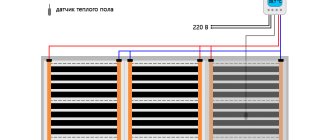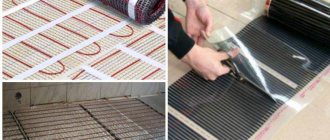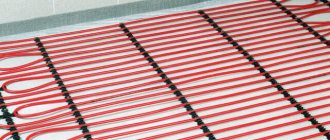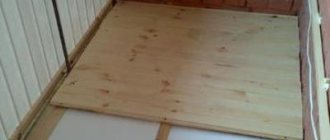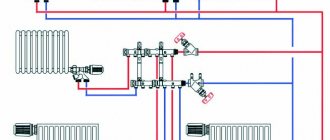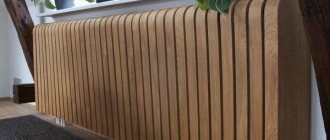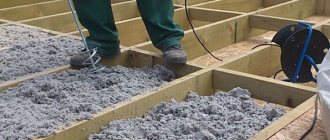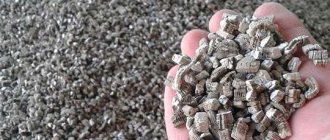In the bathhouse, sauna, in our kitchen or bathroom, we try to use ceramic tiles as flooring. The good old tiles that we are used to are very convenient and practical in terms of use. They try to use it in rooms where there is always high humidity and there is a high probability of water getting on the floor. Ceramics behave resistantly when in contact with water. The glossy smooth surface of the tile and its dense stone structure are stable and not subject to corrosion. In addition, such a surface is very convenient to keep clean, preventing the development of fungus, mold and the accumulation of pathogenic bacteria.
Despite its high performance characteristics, the tiled coating has one significant drawback. The material has extremely low thermal conductivity. The appearance of a tiled floor already a priori creates the impression of a clean and cold surface. In fact, this is true. When we come into physical contact with cold ceramic tiles, we experience discomfort. There is always a desire to make your floor in the bathroom, in the shower compartment of the sauna or in the kitchen warm. This problem can be solved quite simply if the tiles are laid on a warm water floor. How to do it? Let's look at the whole process step by step in detail.
Combination of warm water floors with ceramic tiles
The advent of water underfloor heating has made it possible to radically solve the problem of heating in residential premises. The efficiency of this method of heating interior spaces is an order of magnitude higher in comparison with the operation of traditional heating radiators. The very idea of heating the floor in domestic premises, where there is high humidity and it is technologically necessary to have a clean floor surface, is not new. Heating ceramic floors significantly increases the level of comfort in heated rooms and improves their performance characteristics.
For reference: in the usual version, a tiled floor has a temperature 5-100 lower than the air mass in the floor layer. This is where the “cold floors” effect arises, which we have to put up with.
We remember very well how we felt in the pool, where literally everything was embedded in tiles. It is extremely uncomfortable in such an environment where the walls and floor, despite the apparent cleanliness, are cold, wet and unpleasant to the touch. For the first time, a water heated floor under tiles was installed in England in the mid-50s of the last century. During the construction of the Olympic swimming pool, the competition organizers required the builders to artificially heat the tiled floor inside the pool. Despite the fact that in those years this technical improvement was incredibly expensive, the positive effect of this know-how was immediately appreciated.
Nowadays, such an opportunity is no longer something expensive and unattainable. Warm floors can be found literally everywhere today. Country houses, cottages and dachas, designed for long-term and comfortable living, are massively equipped with heated floors. Laying tiles on water-heated floors is practiced today in the construction of saunas and baths. Many residents try to install a water heating circuit under a ceramic tile covering in the bathroom, toilets or kitchen.
Installing a heated floor heating system in a house involves large-scale work. In old buildings, installing water floors involves solving numerous problems. In new residential buildings, the installation of water heated floors designed for tiles is much simpler and easier.
Laying a warm water floor in inhabited objects solves several problems simultaneously. Even taking into account the very principle of operation of water floors, it already becomes clear what underfloor heating gives in combination with ceramic tiles. The main thing that can be achieved in such cases is to significantly increase the level of comfort in the premises. Frequent visitors to saunas and baths know very well what a warm tiled floor is!
Ceramic tiles and any other ceramic coating in combination with the operation of water heating circuits laid in the floor have many advantages and benefits. Thanks to technological features, heating floors allow you to evenly distribute the required amount of heat over the entire surface of the hearth. The principle of heating the room not only creates an acceptable temperature balance, but also allows you to significantly improve the quality characteristics of the floor covering. When using a concrete screed, tiles are an ideal covering option, especially when it comes to furnishing a kitchen or bathroom.
You can use ceramic coating in combination with a heated floor system. This installation method is especially relevant for country houses, bathhouses and sanitary units, the structure of which is mainly made of wood. The presence of a water floor under the tiles in a bathhouse or sauna is a completely solvable problem. The main thing is to follow the technology of laying the inlaid structure and foresee the flooring option in advance.
Installation methods
This system can be integrated under the tiles in different ways, but the basic principle remains the same: the secret lies in the pipe located in the screed. However, the location of the pipes may vary, and therefore the methods of their fastening. For this reason, they distinguish:
- the use of special plates with grooves for laying pipes;
- installation of the pipeline on a steel mesh or reinforcement.
We recommend: How to install heated floors in a house?
Each of the proposed methods is equally good and the choice of one or the other depends only on the convenience of the location of the room. When implementing the system, in any case, only high-quality materials are needed, otherwise the main heating can easily be damaged, which will lead to irreparable consequences.
Advantages and disadvantages of tiled floor heating
A small bathroom, kitchen or a whole bath complex, all these objects can be successfully heated with water heated floors. Such installation is possible subject to certain conditions. We have a ready-made design of the heating system in hand, in accordance with which the loops of the heating circuit are laid, and service equipment is selected. Thermal calculations will allow you to determine the power of the heating device and make the correct layout of water pipes.
What should you expect in the end? Let us recall the advantages of heated floors covered with tiles or other ceramic material. Eg:
- The heated floor creates a comfortable temperature inside the room.
- The floor surface dries quickly, remaining warm and dry during the use of the room.
- Laying heated floors under tiles does not require additional financial costs.
- Warm floors in the bathroom can be used in combination with traditional radiator heating.
- Heated tiled floors are completely unaffected by the formation of mold and pathogens harmful to humans.
- A tiled floor with water heating will be warm and pleasant to the touch at any time.
- Compliance of warm tiled floors in baths and saunas with the necessary sanitary norms and standards.
Knowing about these advantages, you will definitely want to make a warm floor with your own hands by laying a water circuit under the tiles. From a technical point of view, this process is not particularly difficult. The only condition is strict adherence to installation technology. The design of a water floor requires strict adherence to the sequence of all installation stages.
Important! It should be remembered that tiles significantly increase the strength of the entire structure. In addition to the concrete monolith, a solid ceramic coating is added. In the event of an emergency, without knowing the exact location of the water circuit, you will have to tear off a fairly large fragment of both tiles and concrete screed.
To install water floors in wooden buildings, you should correctly lay the flooring structure, not forgetting about additional sheets of plywood, gypsum fiber board or chipboard. Without additional rigidity, the tiled floor will play, which will certainly affect the integrity of the ceramic surface.
We are considering options for a warm water floor under ceramic tiles
There is no particular difficulty in choosing a water heated floor option for heating premises. The only difference is which installation method to choose: concrete underfloor heating or a flooring system. This depends on what room you plan to work in.
For country houses and wooden buildings, a flooring system would be ideal. The lack of durable concrete floors does not allow the installation of heating floors in a concrete screed in bathhouses, saunas, and dachas. Here it will be successful to use a modular or slatted flooring system. In the usual case, in a permanent, durable stone structure for heated floors, it is best to focus on the construction of a water floor on a concrete base.
For reference: the weight of one sq. meter of concrete screed with heating circuit pipes is 200-300 kg. In a stone building, the interfloor floors are able to withstand such additional load, which cannot be said about wooden buildings.
Having set yourself the task of making heated floors throughout the house or equipping heated floors in the bathroom, start designing water floors on a concrete base. Tiles can be laid on such a surface without any problems. The main condition for using tiles is a perfectly flat surface. With wooden structures of water floors it is quite problematic to achieve this indicator, especially over a large area.
Note: for installing heated floors under ceramic tiles, the technology allows you to create a dry screed. The design has the necessary strength and rigidity. Sheets of plywood, gypsum fiber board or chipboard are laid on top of the stacked structure, with the help of which the surface is leveled.
Having achieved a strong and reliable water floor design and put the heating system into operation, you can begin finishing work and installing the floor covering.
How to carry out thermal calculations?
The optimal coolant temperature that should be in the premises is considered to range from 45 to 50 degrees. If the coating is tiled, then it is enough to have 45 degrees for a comfortable feeling.
We recommend: How to assemble a manifold for underfloor heating?
However, if you have laminate as a floor covering, the temperature should vary from 50 to 55 degrees, because... A fairly large amount of heat is absorbed by wood.
The basis of the calculation is the owner’s desire, i.e. it all depends on what heating intensity the home owner chooses. However, the system is quite flexible, because if desires do not coincide with reality, it can be easily adjusted.
For those who could not decide, there is a deduced norm: on the surface the temperature should be 29 - 35 degrees.
The method of laying pipes also plays a big role. In turn, it depends on which areas of the territory the owner wants to warm up and on the temperature in certain places. To distribute heat evenly, a styling called “Snail” is used.
The principle of its operation is to alternate the return with the primary. This allows you not to feel temperature changes.
How to lay PVC tiles on heated floors
In principle, the installation of water-heating floors under tiles or any other ceramic coating is no different. The water circuit pipes are laid in the traditional order, in the usual pattern, in a snake or snail pattern. The heating circuit pipes should lie closer to the wall panels. Be sure to follow the step during the pipe laying process. For small heated rooms, it is best to focus on a laying step of 20-25 cm. Then everything is done according to the knurled pattern. Either a wooden structure is being assembled, or the water circuits are being filled with concrete.
Important! Laying tiles is carried out only after checking the functionality of the heating system. Otherwise, if the water loops are not laid correctly and there is an emergency leak, you will have to tear off the tiles. All your work will go down the drain.
When starting to work with tiles, you must carefully prepare the floor surface. Whether it's a concrete screed or a flooring system, you'll still need to clean the floor until it's perfectly clean and level.
The evenness of the floor is not a whim of the craftsmen. In addition to the fact that the tile covering will lie firmly on the floor, an even screed will ensure proper heat distribution over the entire surface of the floor. The tiles are laid on an adhesive base. Tile adhesive must be waterproof and non-toxic. When the floor is heated, intense evaporation of the chemicals contained in the floor coverings is often observed. Therefore, when choosing an adhesive, be sure to look at its labeling.
